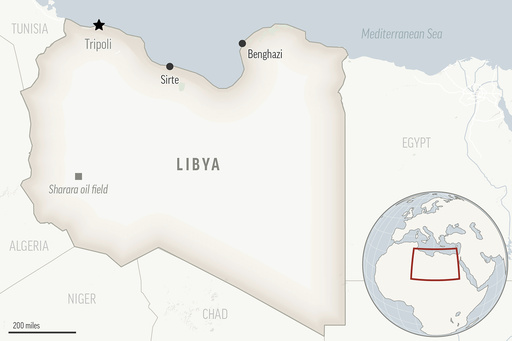
CAIRO — Libyan authorities have reported the discovery of nearly 50 deceased individuals in two separate mass graves located in the country’s southeastern desert, a grim development related to the ongoing migrant crisis in North Africa. This tragic situation underscores the dangers faced by those attempting to reach Europe.
On Friday, officials unearthed the first mass grave, which contained 19 bodies, at a farm in the southeastern city of Kufra. The security directorate confirmed this in a statement, mentioning that the bodies have been taken for autopsy procedures. Authorities shared images on social media showing their teams digging through the sand to recover the deceased, who were found wrapped in blankets.
The al-Abreen charity, an organization assisting migrants in eastern and southern Libya, stated that some of the individuals appeared to have been shot prior to their burial. In addition, a second mass grave with a minimum of 30 bodies was also discovered in Kufra during a raid on a human trafficking site. According to Mohamed al-Fadeil, the head of the security chamber in Kufra, survivors claimed that nearly 70 people may be buried in that grave. Efforts to search the area continued.
In a subsequent operation, authorities announced on Sunday that they had rescued 76 migrants from the trafficking center and apprehended three suspects: a Libyan national and two foreigners believed to be involved in the detention and mistreatment of migrants. Prosecutors have ordered that the suspects remain in custody while investigations are underway.
Mass graves of migrants are sadly not an unusual finding in Libya. In the previous year, investigators uncovered the remains of at least 65 migrants in the Shuayrif area, situated approximately 350 kilometers (220 miles) south of Tripoli, the capital. Libya remains a primary transit point for migrants from Africa and the Middle East endeavoring to reach Europe, a situation exacerbated by the chaos that ensued following the NATO-supported ousting of long-time leader Muammar Gaddafi in 2011. For over a decade, Libya has been divided between rival governments in the east and west, both of which are supported by various militias and foreign powers.
Human traffickers have exploitatively profited from Libya’s prolonged instability, smuggling migrants across borders with neighboring countries such as Chad, Niger, Sudan, Egypt, Algeria, and Tunisia. Once they reach the coast, these traffickers cram desperate migrants, who are in search of a better life in Europe, into poorly equipped rubber boats and other vessels, sending them on perilous journeys across the Central Mediterranean Sea.
For several years, rights organizations and UN agencies have reported pervasive abuse of migrants in Libya, which includes forced labor, physical assaults, sexual violence, and torture. Such abuses often occur alongside extortion efforts aimed at obtaining money from the migrants’ families before allowing them to depart on traffickers’ vessels. Those intercepted and sent back to Libya, including vulnerable groups such as women and children, are often imprisoned in government-run detention facilities, where they continue to face mistreatment, including torture, rape, and extortion, as corroborated by various rights groups and experts from the UN.

